Analyzing Innovation and Business Model Development at CBA, Australia
VerifiedAdded on 2023/06/13
|7
|2125
|289
Essay
AI Summary
This essay provides an analysis of the business model of Commonwealth Bank Australia, focusing on its approach to innovation and sustainable business development. It examines the views of different authors on business models and disruption, and discusses the opportunities and threats that Commonwealth Bank faces through the use of smart-connected products. The essay also includes a business model canvas for the bank, highlighting key resources and value propositions. It emphasizes how the bank can leverage disruptive innovation and technology to enhance its competitive advantage and service delivery, while addressing challenges related to technology adoption and data security. Desklib offers a variety of resources for students, including solved assignments and past papers.
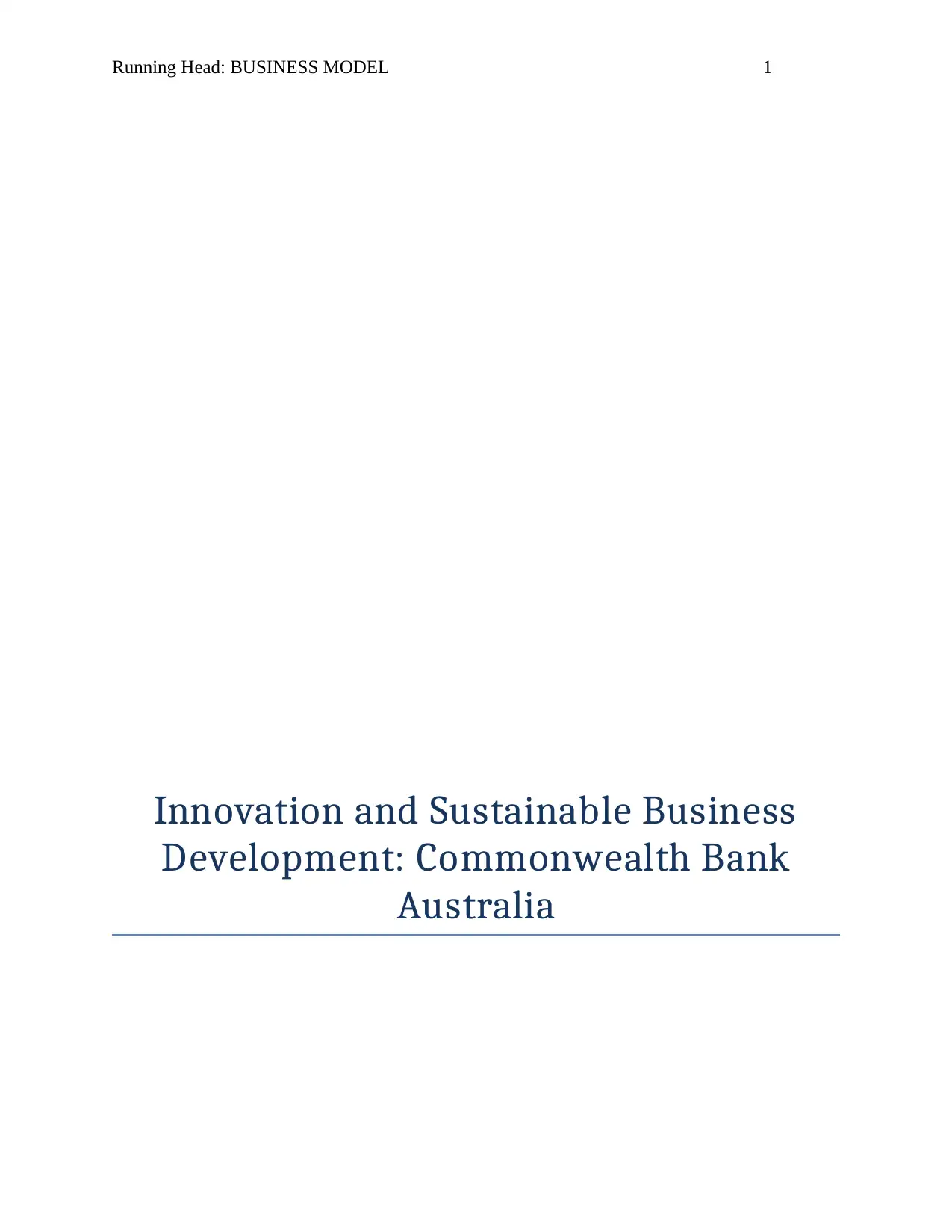
Running Head: BUSINESS MODEL 1
Innovation and Sustainable Business
Development: Commonwealth Bank
Australia
Innovation and Sustainable Business
Development: Commonwealth Bank
Australia
Paraphrase This Document
Need a fresh take? Get an instant paraphrase of this document with our AI Paraphraser
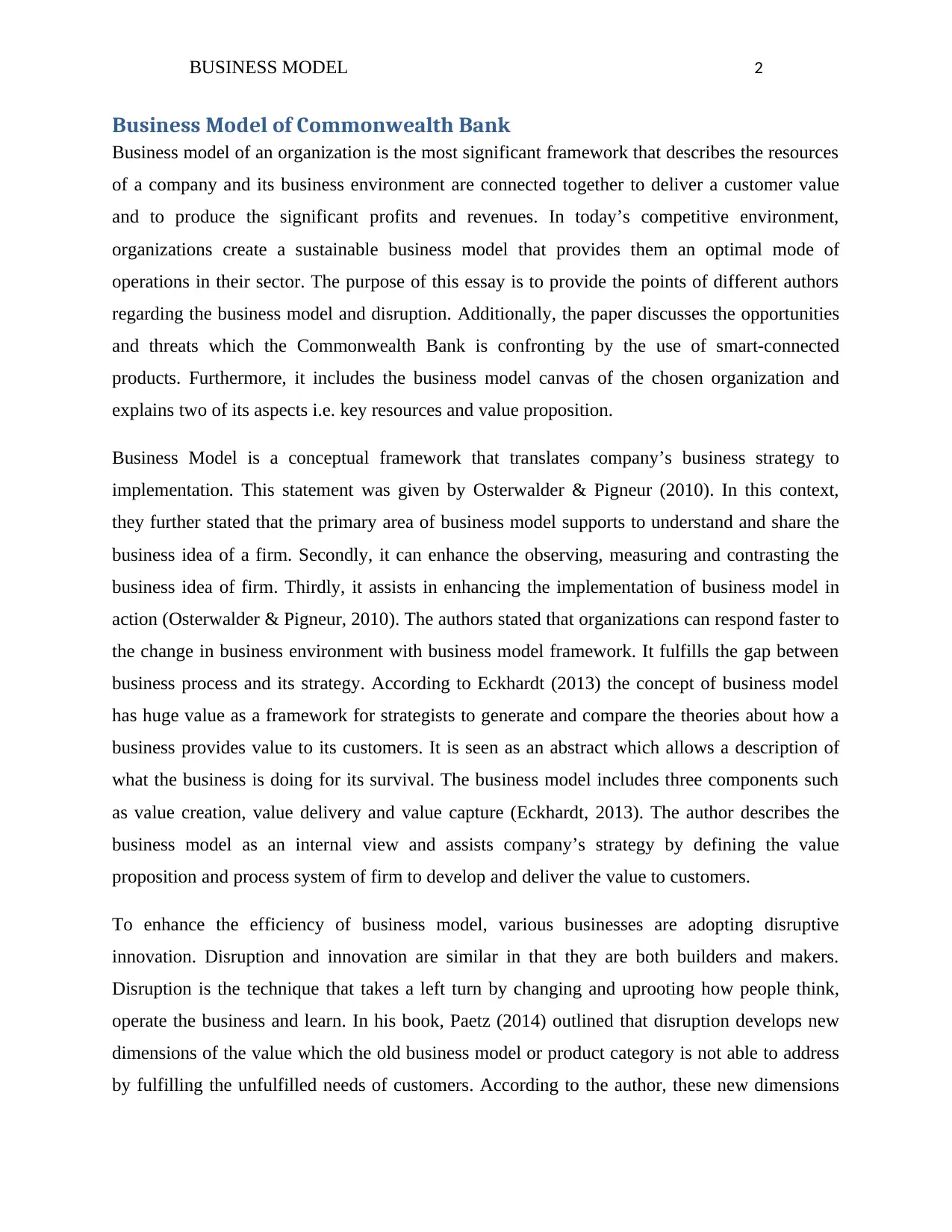
BUSINESS MODEL 2
Business Model of Commonwealth Bank
Business model of an organization is the most significant framework that describes the resources
of a company and its business environment are connected together to deliver a customer value
and to produce the significant profits and revenues. In today’s competitive environment,
organizations create a sustainable business model that provides them an optimal mode of
operations in their sector. The purpose of this essay is to provide the points of different authors
regarding the business model and disruption. Additionally, the paper discusses the opportunities
and threats which the Commonwealth Bank is confronting by the use of smart-connected
products. Furthermore, it includes the business model canvas of the chosen organization and
explains two of its aspects i.e. key resources and value proposition.
Business Model is a conceptual framework that translates company’s business strategy to
implementation. This statement was given by Osterwalder & Pigneur (2010). In this context,
they further stated that the primary area of business model supports to understand and share the
business idea of a firm. Secondly, it can enhance the observing, measuring and contrasting the
business idea of firm. Thirdly, it assists in enhancing the implementation of business model in
action (Osterwalder & Pigneur, 2010). The authors stated that organizations can respond faster to
the change in business environment with business model framework. It fulfills the gap between
business process and its strategy. According to Eckhardt (2013) the concept of business model
has huge value as a framework for strategists to generate and compare the theories about how a
business provides value to its customers. It is seen as an abstract which allows a description of
what the business is doing for its survival. The business model includes three components such
as value creation, value delivery and value capture (Eckhardt, 2013). The author describes the
business model as an internal view and assists company’s strategy by defining the value
proposition and process system of firm to develop and deliver the value to customers.
To enhance the efficiency of business model, various businesses are adopting disruptive
innovation. Disruption and innovation are similar in that they are both builders and makers.
Disruption is the technique that takes a left turn by changing and uprooting how people think,
operate the business and learn. In his book, Paetz (2014) outlined that disruption develops new
dimensions of the value which the old business model or product category is not able to address
by fulfilling the unfulfilled needs of customers. According to the author, these new dimensions
Business Model of Commonwealth Bank
Business model of an organization is the most significant framework that describes the resources
of a company and its business environment are connected together to deliver a customer value
and to produce the significant profits and revenues. In today’s competitive environment,
organizations create a sustainable business model that provides them an optimal mode of
operations in their sector. The purpose of this essay is to provide the points of different authors
regarding the business model and disruption. Additionally, the paper discusses the opportunities
and threats which the Commonwealth Bank is confronting by the use of smart-connected
products. Furthermore, it includes the business model canvas of the chosen organization and
explains two of its aspects i.e. key resources and value proposition.
Business Model is a conceptual framework that translates company’s business strategy to
implementation. This statement was given by Osterwalder & Pigneur (2010). In this context,
they further stated that the primary area of business model supports to understand and share the
business idea of a firm. Secondly, it can enhance the observing, measuring and contrasting the
business idea of firm. Thirdly, it assists in enhancing the implementation of business model in
action (Osterwalder & Pigneur, 2010). The authors stated that organizations can respond faster to
the change in business environment with business model framework. It fulfills the gap between
business process and its strategy. According to Eckhardt (2013) the concept of business model
has huge value as a framework for strategists to generate and compare the theories about how a
business provides value to its customers. It is seen as an abstract which allows a description of
what the business is doing for its survival. The business model includes three components such
as value creation, value delivery and value capture (Eckhardt, 2013). The author describes the
business model as an internal view and assists company’s strategy by defining the value
proposition and process system of firm to develop and deliver the value to customers.
To enhance the efficiency of business model, various businesses are adopting disruptive
innovation. Disruption and innovation are similar in that they are both builders and makers.
Disruption is the technique that takes a left turn by changing and uprooting how people think,
operate the business and learn. In his book, Paetz (2014) outlined that disruption develops new
dimensions of the value which the old business model or product category is not able to address
by fulfilling the unfulfilled needs of customers. According to the author, these new dimensions
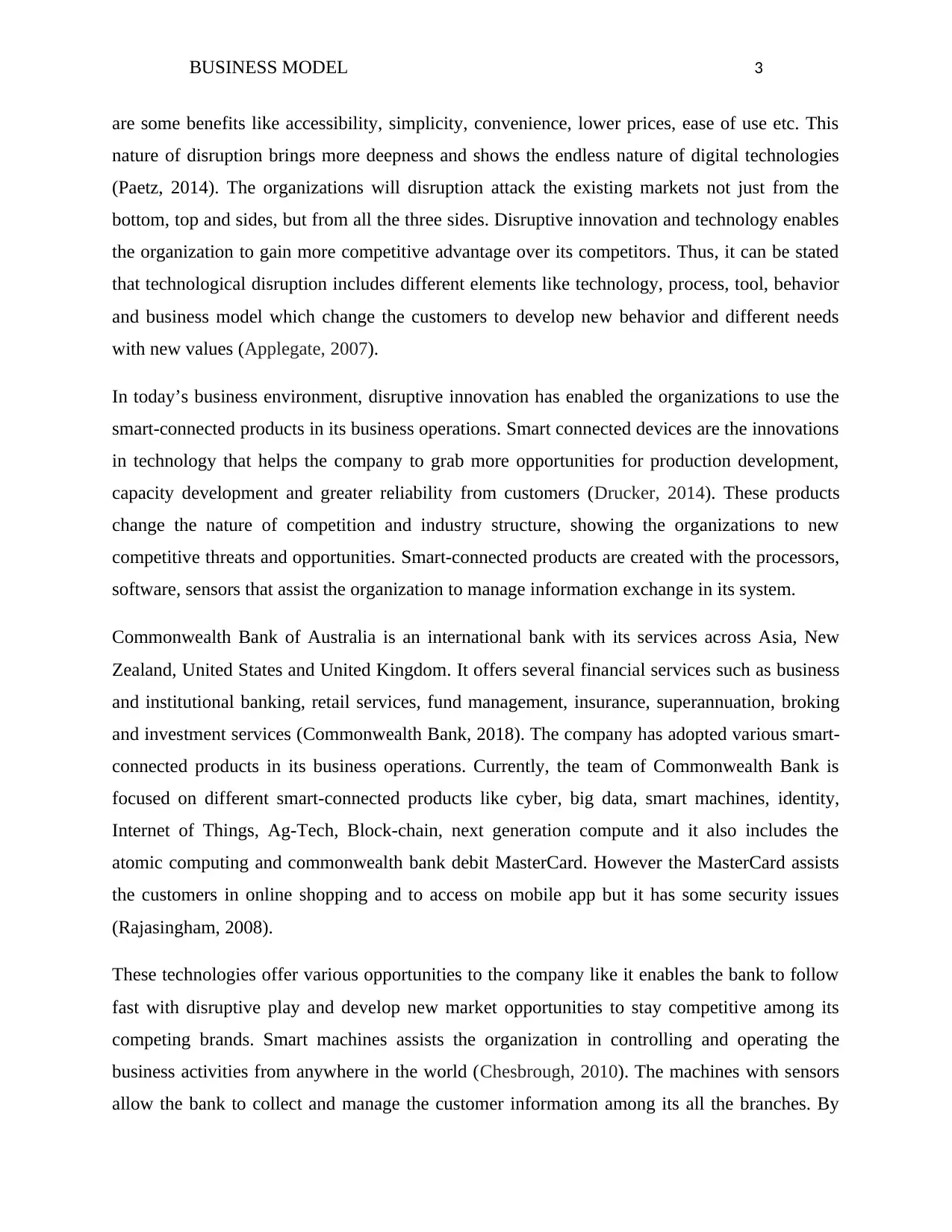
BUSINESS MODEL 3
are some benefits like accessibility, simplicity, convenience, lower prices, ease of use etc. This
nature of disruption brings more deepness and shows the endless nature of digital technologies
(Paetz, 2014). The organizations will disruption attack the existing markets not just from the
bottom, top and sides, but from all the three sides. Disruptive innovation and technology enables
the organization to gain more competitive advantage over its competitors. Thus, it can be stated
that technological disruption includes different elements like technology, process, tool, behavior
and business model which change the customers to develop new behavior and different needs
with new values (Applegate, 2007).
In today’s business environment, disruptive innovation has enabled the organizations to use the
smart-connected products in its business operations. Smart connected devices are the innovations
in technology that helps the company to grab more opportunities for production development,
capacity development and greater reliability from customers (Drucker, 2014). These products
change the nature of competition and industry structure, showing the organizations to new
competitive threats and opportunities. Smart-connected products are created with the processors,
software, sensors that assist the organization to manage information exchange in its system.
Commonwealth Bank of Australia is an international bank with its services across Asia, New
Zealand, United States and United Kingdom. It offers several financial services such as business
and institutional banking, retail services, fund management, insurance, superannuation, broking
and investment services (Commonwealth Bank, 2018). The company has adopted various smart-
connected products in its business operations. Currently, the team of Commonwealth Bank is
focused on different smart-connected products like cyber, big data, smart machines, identity,
Internet of Things, Ag-Tech, Block-chain, next generation compute and it also includes the
atomic computing and commonwealth bank debit MasterCard. However the MasterCard assists
the customers in online shopping and to access on mobile app but it has some security issues
(Rajasingham, 2008).
These technologies offer various opportunities to the company like it enables the bank to follow
fast with disruptive play and develop new market opportunities to stay competitive among its
competing brands. Smart machines assists the organization in controlling and operating the
business activities from anywhere in the world (Chesbrough, 2010). The machines with sensors
allow the bank to collect and manage the customer information among its all the branches. By
are some benefits like accessibility, simplicity, convenience, lower prices, ease of use etc. This
nature of disruption brings more deepness and shows the endless nature of digital technologies
(Paetz, 2014). The organizations will disruption attack the existing markets not just from the
bottom, top and sides, but from all the three sides. Disruptive innovation and technology enables
the organization to gain more competitive advantage over its competitors. Thus, it can be stated
that technological disruption includes different elements like technology, process, tool, behavior
and business model which change the customers to develop new behavior and different needs
with new values (Applegate, 2007).
In today’s business environment, disruptive innovation has enabled the organizations to use the
smart-connected products in its business operations. Smart connected devices are the innovations
in technology that helps the company to grab more opportunities for production development,
capacity development and greater reliability from customers (Drucker, 2014). These products
change the nature of competition and industry structure, showing the organizations to new
competitive threats and opportunities. Smart-connected products are created with the processors,
software, sensors that assist the organization to manage information exchange in its system.
Commonwealth Bank of Australia is an international bank with its services across Asia, New
Zealand, United States and United Kingdom. It offers several financial services such as business
and institutional banking, retail services, fund management, insurance, superannuation, broking
and investment services (Commonwealth Bank, 2018). The company has adopted various smart-
connected products in its business operations. Currently, the team of Commonwealth Bank is
focused on different smart-connected products like cyber, big data, smart machines, identity,
Internet of Things, Ag-Tech, Block-chain, next generation compute and it also includes the
atomic computing and commonwealth bank debit MasterCard. However the MasterCard assists
the customers in online shopping and to access on mobile app but it has some security issues
(Rajasingham, 2008).
These technologies offer various opportunities to the company like it enables the bank to follow
fast with disruptive play and develop new market opportunities to stay competitive among its
competing brands. Smart machines assists the organization in controlling and operating the
business activities from anywhere in the world (Chesbrough, 2010). The machines with sensors
allow the bank to collect and manage the customer information among its all the branches. By
⊘ This is a preview!⊘
Do you want full access?
Subscribe today to unlock all pages.

Trusted by 1+ million students worldwide
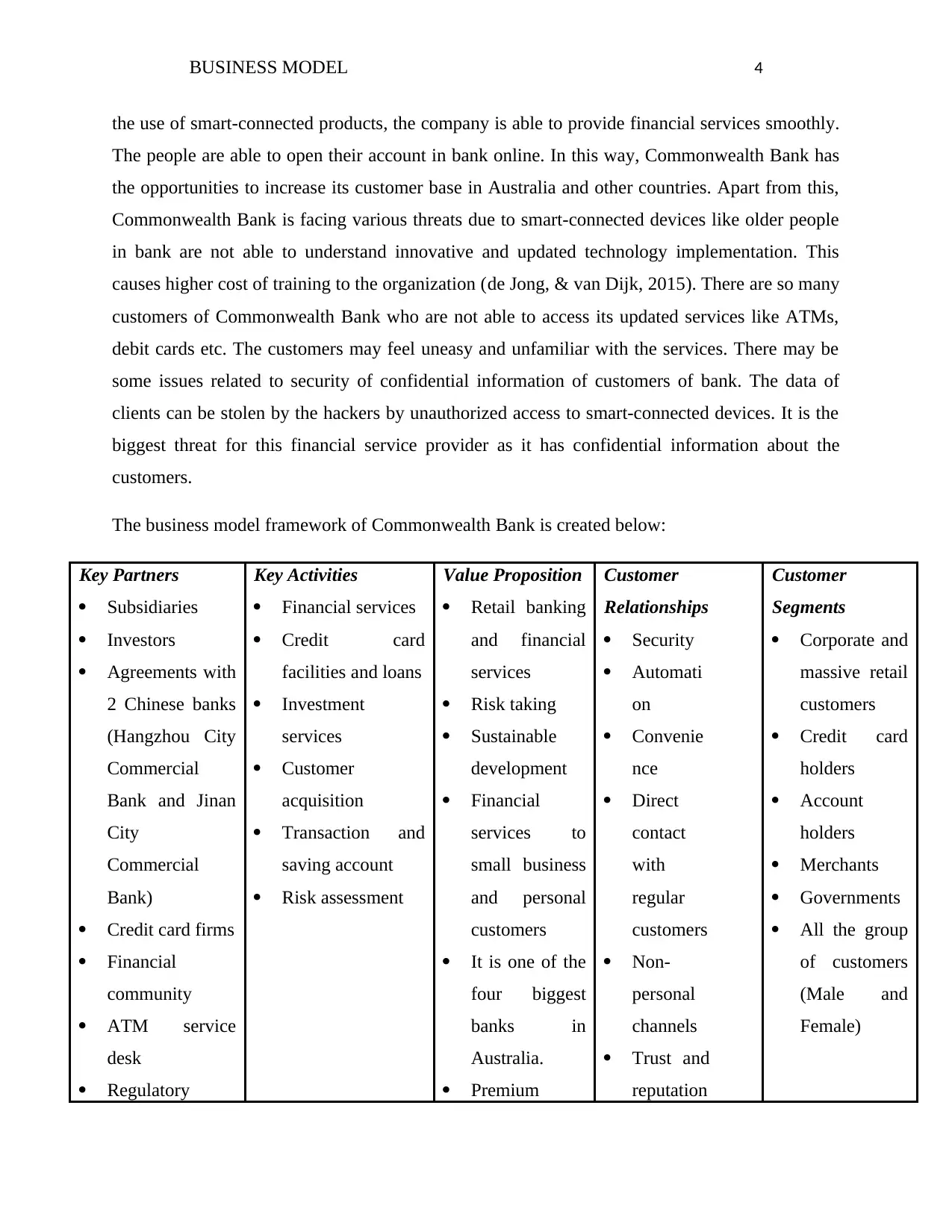
BUSINESS MODEL 4
the use of smart-connected products, the company is able to provide financial services smoothly.
The people are able to open their account in bank online. In this way, Commonwealth Bank has
the opportunities to increase its customer base in Australia and other countries. Apart from this,
Commonwealth Bank is facing various threats due to smart-connected devices like older people
in bank are not able to understand innovative and updated technology implementation. This
causes higher cost of training to the organization (de Jong, & van Dijk, 2015). There are so many
customers of Commonwealth Bank who are not able to access its updated services like ATMs,
debit cards etc. The customers may feel uneasy and unfamiliar with the services. There may be
some issues related to security of confidential information of customers of bank. The data of
clients can be stolen by the hackers by unauthorized access to smart-connected devices. It is the
biggest threat for this financial service provider as it has confidential information about the
customers.
The business model framework of Commonwealth Bank is created below:
Key Partners
Subsidiaries
Investors
Agreements with
2 Chinese banks
(Hangzhou City
Commercial
Bank and Jinan
City
Commercial
Bank)
Credit card firms
Financial
community
ATM service
desk
Regulatory
Key Activities
Financial services
Credit card
facilities and loans
Investment
services
Customer
acquisition
Transaction and
saving account
Risk assessment
Value Proposition
Retail banking
and financial
services
Risk taking
Sustainable
development
Financial
services to
small business
and personal
customers
It is one of the
four biggest
banks in
Australia.
Premium
Customer
Relationships
Security
Automati
on
Convenie
nce
Direct
contact
with
regular
customers
Non-
personal
channels
Trust and
reputation
Customer
Segments
Corporate and
massive retail
customers
Credit card
holders
Account
holders
Merchants
Governments
All the group
of customers
(Male and
Female)
the use of smart-connected products, the company is able to provide financial services smoothly.
The people are able to open their account in bank online. In this way, Commonwealth Bank has
the opportunities to increase its customer base in Australia and other countries. Apart from this,
Commonwealth Bank is facing various threats due to smart-connected devices like older people
in bank are not able to understand innovative and updated technology implementation. This
causes higher cost of training to the organization (de Jong, & van Dijk, 2015). There are so many
customers of Commonwealth Bank who are not able to access its updated services like ATMs,
debit cards etc. The customers may feel uneasy and unfamiliar with the services. There may be
some issues related to security of confidential information of customers of bank. The data of
clients can be stolen by the hackers by unauthorized access to smart-connected devices. It is the
biggest threat for this financial service provider as it has confidential information about the
customers.
The business model framework of Commonwealth Bank is created below:
Key Partners
Subsidiaries
Investors
Agreements with
2 Chinese banks
(Hangzhou City
Commercial
Bank and Jinan
City
Commercial
Bank)
Credit card firms
Financial
community
ATM service
desk
Regulatory
Key Activities
Financial services
Credit card
facilities and loans
Investment
services
Customer
acquisition
Transaction and
saving account
Risk assessment
Value Proposition
Retail banking
and financial
services
Risk taking
Sustainable
development
Financial
services to
small business
and personal
customers
It is one of the
four biggest
banks in
Australia.
Premium
Customer
Relationships
Security
Automati
on
Convenie
nce
Direct
contact
with
regular
customers
Non-
personal
channels
Trust and
reputation
Customer
Segments
Corporate and
massive retail
customers
Credit card
holders
Account
holders
Merchants
Governments
All the group
of customers
(Male and
Female)
Paraphrase This Document
Need a fresh take? Get an instant paraphrase of this document with our AI Paraphraser
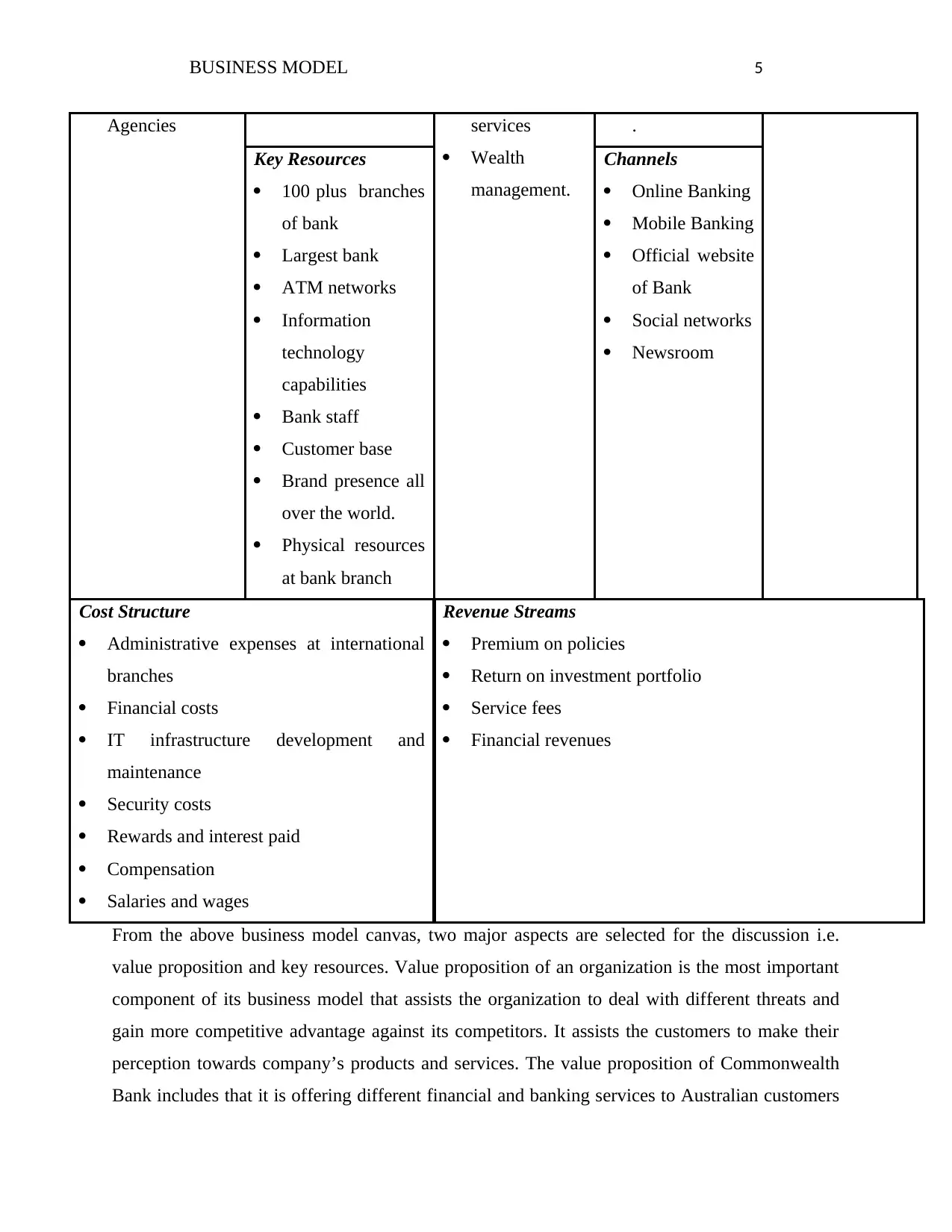
BUSINESS MODEL 5
Agencies services
Wealth
management.
.
Key Resources
100 plus branches
of bank
Largest bank
ATM networks
Information
technology
capabilities
Bank staff
Customer base
Brand presence all
over the world.
Physical resources
at bank branch
Channels
Online Banking
Mobile Banking
Official website
of Bank
Social networks
Newsroom
Cost Structure
Administrative expenses at international
branches
Financial costs
IT infrastructure development and
maintenance
Security costs
Rewards and interest paid
Compensation
Salaries and wages
Revenue Streams
Premium on policies
Return on investment portfolio
Service fees
Financial revenues
From the above business model canvas, two major aspects are selected for the discussion i.e.
value proposition and key resources. Value proposition of an organization is the most important
component of its business model that assists the organization to deal with different threats and
gain more competitive advantage against its competitors. It assists the customers to make their
perception towards company’s products and services. The value proposition of Commonwealth
Bank includes that it is offering different financial and banking services to Australian customers
Agencies services
Wealth
management.
.
Key Resources
100 plus branches
of bank
Largest bank
ATM networks
Information
technology
capabilities
Bank staff
Customer base
Brand presence all
over the world.
Physical resources
at bank branch
Channels
Online Banking
Mobile Banking
Official website
of Bank
Social networks
Newsroom
Cost Structure
Administrative expenses at international
branches
Financial costs
IT infrastructure development and
maintenance
Security costs
Rewards and interest paid
Compensation
Salaries and wages
Revenue Streams
Premium on policies
Return on investment portfolio
Service fees
Financial revenues
From the above business model canvas, two major aspects are selected for the discussion i.e.
value proposition and key resources. Value proposition of an organization is the most important
component of its business model that assists the organization to deal with different threats and
gain more competitive advantage against its competitors. It assists the customers to make their
perception towards company’s products and services. The value proposition of Commonwealth
Bank includes that it is offering different financial and banking services to Australian customers
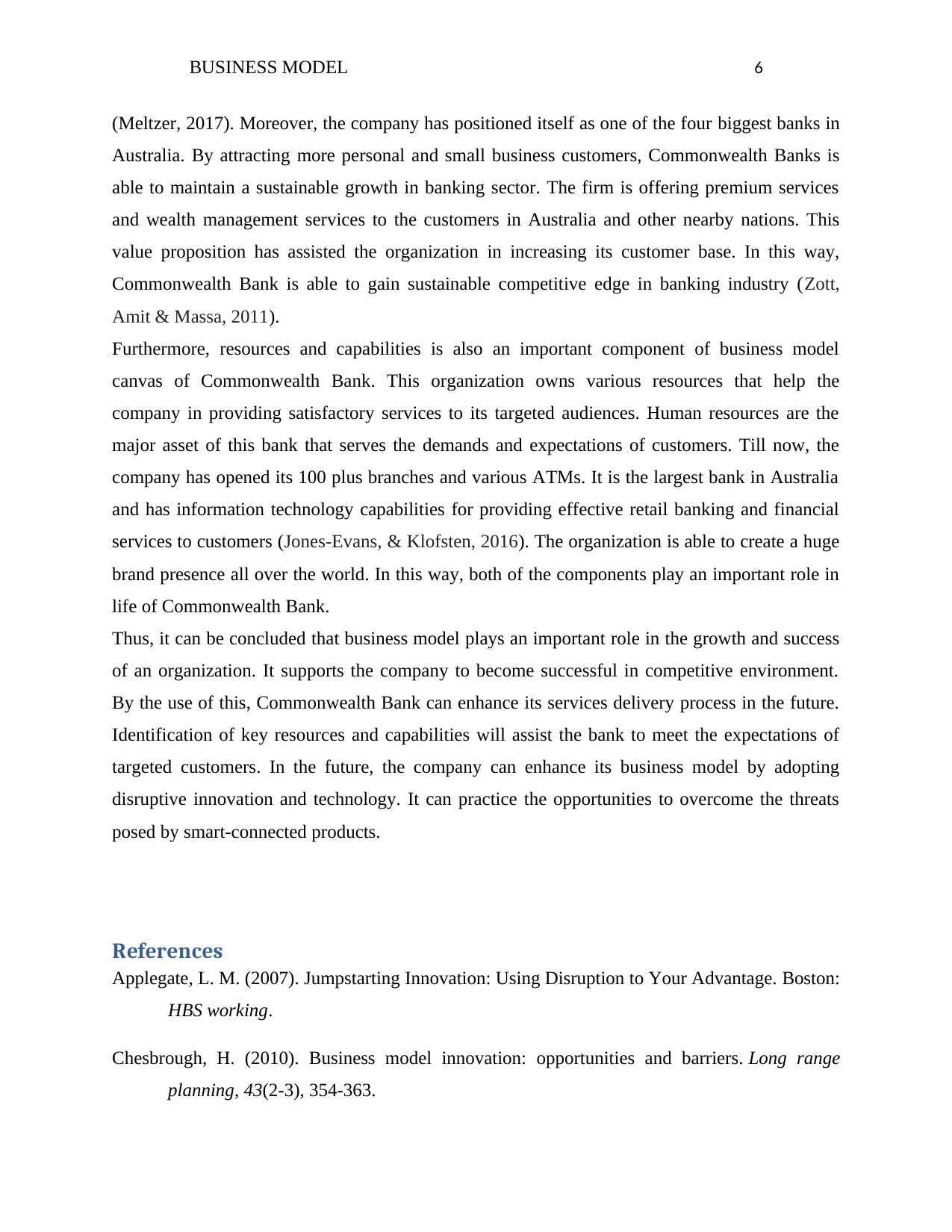
BUSINESS MODEL 6
(Meltzer, 2017). Moreover, the company has positioned itself as one of the four biggest banks in
Australia. By attracting more personal and small business customers, Commonwealth Banks is
able to maintain a sustainable growth in banking sector. The firm is offering premium services
and wealth management services to the customers in Australia and other nearby nations. This
value proposition has assisted the organization in increasing its customer base. In this way,
Commonwealth Bank is able to gain sustainable competitive edge in banking industry (Zott,
Amit & Massa, 2011).
Furthermore, resources and capabilities is also an important component of business model
canvas of Commonwealth Bank. This organization owns various resources that help the
company in providing satisfactory services to its targeted audiences. Human resources are the
major asset of this bank that serves the demands and expectations of customers. Till now, the
company has opened its 100 plus branches and various ATMs. It is the largest bank in Australia
and has information technology capabilities for providing effective retail banking and financial
services to customers (Jones-Evans, & Klofsten, 2016). The organization is able to create a huge
brand presence all over the world. In this way, both of the components play an important role in
life of Commonwealth Bank.
Thus, it can be concluded that business model plays an important role in the growth and success
of an organization. It supports the company to become successful in competitive environment.
By the use of this, Commonwealth Bank can enhance its services delivery process in the future.
Identification of key resources and capabilities will assist the bank to meet the expectations of
targeted customers. In the future, the company can enhance its business model by adopting
disruptive innovation and technology. It can practice the opportunities to overcome the threats
posed by smart-connected products.
References
Applegate, L. M. (2007). Jumpstarting Innovation: Using Disruption to Your Advantage. Boston:
HBS working.
Chesbrough, H. (2010). Business model innovation: opportunities and barriers. Long range
planning, 43(2-3), 354-363.
(Meltzer, 2017). Moreover, the company has positioned itself as one of the four biggest banks in
Australia. By attracting more personal and small business customers, Commonwealth Banks is
able to maintain a sustainable growth in banking sector. The firm is offering premium services
and wealth management services to the customers in Australia and other nearby nations. This
value proposition has assisted the organization in increasing its customer base. In this way,
Commonwealth Bank is able to gain sustainable competitive edge in banking industry (Zott,
Amit & Massa, 2011).
Furthermore, resources and capabilities is also an important component of business model
canvas of Commonwealth Bank. This organization owns various resources that help the
company in providing satisfactory services to its targeted audiences. Human resources are the
major asset of this bank that serves the demands and expectations of customers. Till now, the
company has opened its 100 plus branches and various ATMs. It is the largest bank in Australia
and has information technology capabilities for providing effective retail banking and financial
services to customers (Jones-Evans, & Klofsten, 2016). The organization is able to create a huge
brand presence all over the world. In this way, both of the components play an important role in
life of Commonwealth Bank.
Thus, it can be concluded that business model plays an important role in the growth and success
of an organization. It supports the company to become successful in competitive environment.
By the use of this, Commonwealth Bank can enhance its services delivery process in the future.
Identification of key resources and capabilities will assist the bank to meet the expectations of
targeted customers. In the future, the company can enhance its business model by adopting
disruptive innovation and technology. It can practice the opportunities to overcome the threats
posed by smart-connected products.
References
Applegate, L. M. (2007). Jumpstarting Innovation: Using Disruption to Your Advantage. Boston:
HBS working.
Chesbrough, H. (2010). Business model innovation: opportunities and barriers. Long range
planning, 43(2-3), 354-363.
⊘ This is a preview!⊘
Do you want full access?
Subscribe today to unlock all pages.

Trusted by 1+ million students worldwide
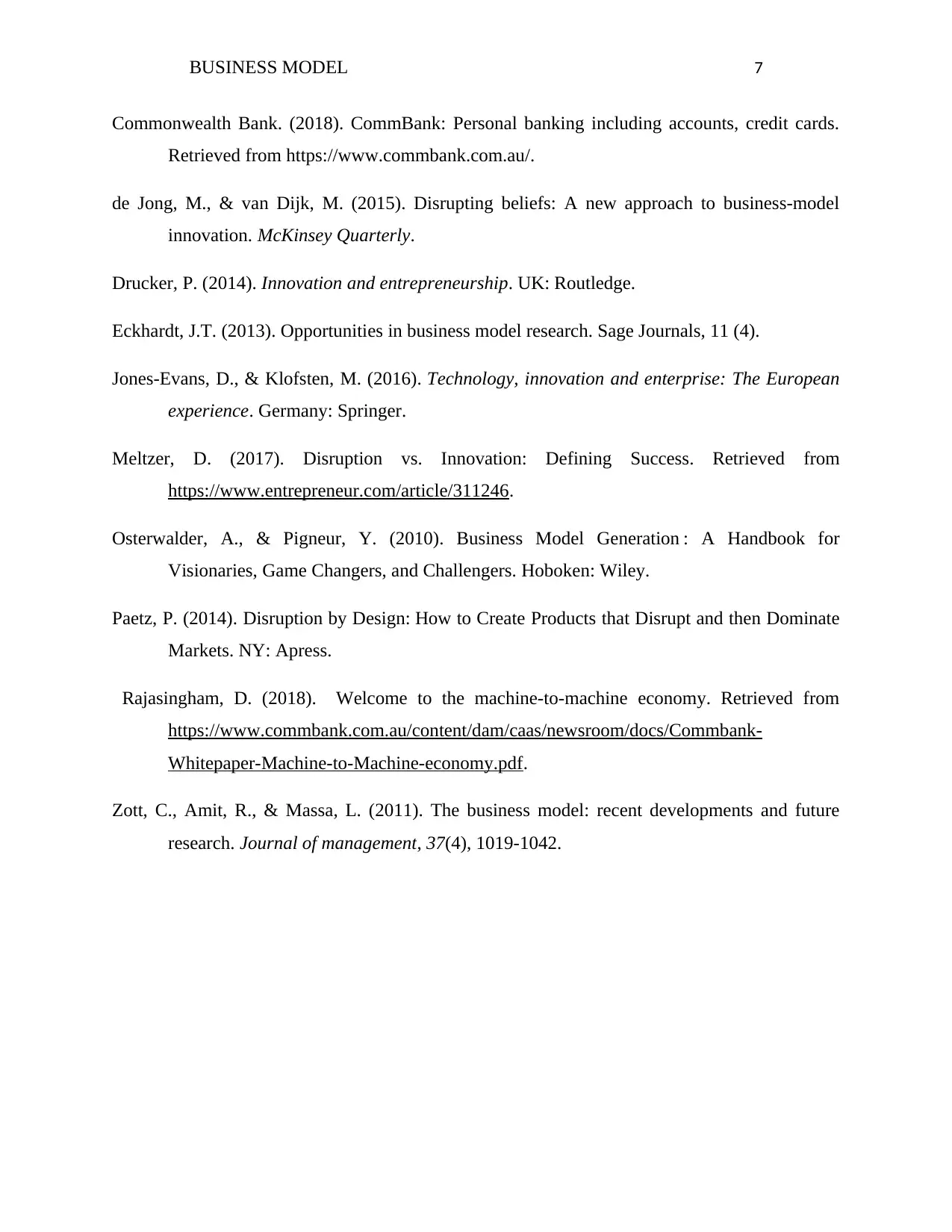
BUSINESS MODEL 7
Commonwealth Bank. (2018). CommBank: Personal banking including accounts, credit cards.
Retrieved from https://www.commbank.com.au/.
de Jong, M., & van Dijk, M. (2015). Disrupting beliefs: A new approach to business-model
innovation. McKinsey Quarterly.
Drucker, P. (2014). Innovation and entrepreneurship. UK: Routledge.
Eckhardt, J.T. (2013). Opportunities in business model research. Sage Journals, 11 (4).
Jones-Evans, D., & Klofsten, M. (2016). Technology, innovation and enterprise: The European
experience. Germany: Springer.
Meltzer, D. (2017). Disruption vs. Innovation: Defining Success. Retrieved from
https://www.entrepreneur.com/article/311246.
Osterwalder, A., & Pigneur, Y. (2010). Business Model Generation : A Handbook for
Visionaries, Game Changers, and Challengers. Hoboken: Wiley.
Paetz, P. (2014). Disruption by Design: How to Create Products that Disrupt and then Dominate
Markets. NY: Apress.
Rajasingham, D. (2018). Welcome to the machine-to-machine economy. Retrieved from
https://www.commbank.com.au/content/dam/caas/newsroom/docs/Commbank-
Whitepaper-Machine-to-Machine-economy.pdf.
Zott, C., Amit, R., & Massa, L. (2011). The business model: recent developments and future
research. Journal of management, 37(4), 1019-1042.
Commonwealth Bank. (2018). CommBank: Personal banking including accounts, credit cards.
Retrieved from https://www.commbank.com.au/.
de Jong, M., & van Dijk, M. (2015). Disrupting beliefs: A new approach to business-model
innovation. McKinsey Quarterly.
Drucker, P. (2014). Innovation and entrepreneurship. UK: Routledge.
Eckhardt, J.T. (2013). Opportunities in business model research. Sage Journals, 11 (4).
Jones-Evans, D., & Klofsten, M. (2016). Technology, innovation and enterprise: The European
experience. Germany: Springer.
Meltzer, D. (2017). Disruption vs. Innovation: Defining Success. Retrieved from
https://www.entrepreneur.com/article/311246.
Osterwalder, A., & Pigneur, Y. (2010). Business Model Generation : A Handbook for
Visionaries, Game Changers, and Challengers. Hoboken: Wiley.
Paetz, P. (2014). Disruption by Design: How to Create Products that Disrupt and then Dominate
Markets. NY: Apress.
Rajasingham, D. (2018). Welcome to the machine-to-machine economy. Retrieved from
https://www.commbank.com.au/content/dam/caas/newsroom/docs/Commbank-
Whitepaper-Machine-to-Machine-economy.pdf.
Zott, C., Amit, R., & Massa, L. (2011). The business model: recent developments and future
research. Journal of management, 37(4), 1019-1042.
1 out of 7
Related Documents
Your All-in-One AI-Powered Toolkit for Academic Success.
+13062052269
info@desklib.com
Available 24*7 on WhatsApp / Email
![[object Object]](/_next/static/media/star-bottom.7253800d.svg)
Unlock your academic potential
Copyright © 2020–2025 A2Z Services. All Rights Reserved. Developed and managed by ZUCOL.




